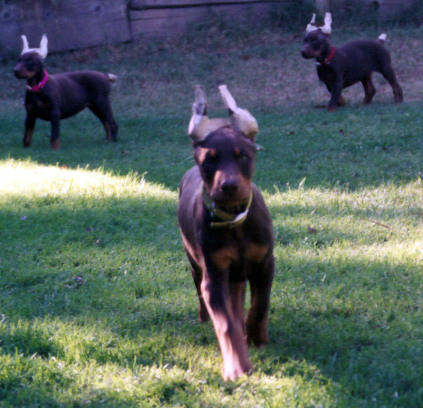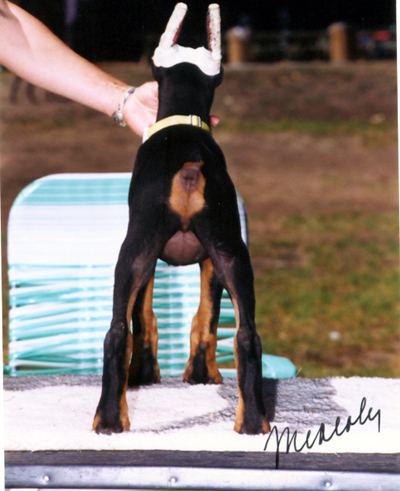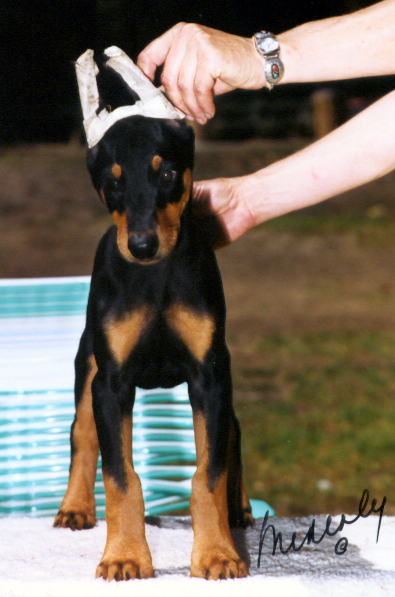submitted by Marj Brooks, USA
The bone and angle structure for most breeds is basically the same with some exceptions here and there. Weimaraners and Dobermans are basically the same except for breed specifics. The 8th week is proven to be the best time to judge structure in most all dogs.
“STRONG” PUPPY MOVEMENT

It is up to us, in whatever the breed, to judge in the puppy for the breed specifics that makes the breed what it is. A lot of us are what you call, “lucky”. Grading 8-week-old puppies is an educated guess and there are no guarantees.
The differences in small puppies are so minute when compared to an adult. Like a fraction of an inch difference could be an inch in an adult.
Example: An upper arm that is 1/8 inch shorter than the shoulder blade and foreleg could be a whole inch shorter as an adult.
Hopefully you are observing and watching them from birth to grading time and noting things that you see. For grading, I like to take them to a place that they haven´t been before to evaluate their temperament as well as how they look confirmation-wise and moving around. Here, you look and grade for all the descriptive words in our 1st paragraph of our standard.
Balance is the big word, in my opinion, in our standard, so while they are on the ground, look for that while they are standing free and moving around as well as proportions. A new environment is the best for judging temperament because it´s a new place; judge temperament first. Is the puppy curious, alert, determined, etc. (study the standard and compare)?
When evaluating them on the table I do not use food or do  a lot of handling. I like to
a lot of handling. I like to
REAR – STRENGTH – WISH BONE LOOK
hold them up off the table (like handling a toy dog – i.e. Chihuahua or Min Pin). After they relax their legs I place them on the table and judge them that way (as they land), in the way that they want to naturally fall. You want their front legs to drop underneath them and parallel to each other and perpendicular to the body and ground. The rear legs in their proper place. You look at the whole puppy in balance and proportions. When viewing the front from the front, you want legs basically straight and parallel, elbows fitting against the body. When viewing the rear you want a balanced, wide set, almost like a wishbone muscling equal on each side of the legs along with strong hocks, etc. From the side, look for neck placement and shoulders – length and depth of rib cage and keel, portion of breast bone running between the forelegs and extending backward to the line of the abdomen, short loin and other specifics in our standard. Looking for balance is our best bet as is strength in the outline of a nice, tight, little square package with “soft curves” … no abrupt angles.
STANDING IN MOTION
I do not like to use food because I want the puppy to look around on it´s own (temperament) and stand as close to natural as possible. Almost all of us can manipulate a puppy to look fabulous. For me, the less fixing the better. On the grading day there is no point in kidding ourselves.
I say – know your standard and learn basic structure and don´t forget temperament, which is a most important part of the grading of each individual.
FRONT ELBOWS TIGHT TO THE BODY
References:
K-9 structure and terminology by Edward Gilbert Jr. & Thelma Brown.
Tricks of the Trade and video Puppy Puzzle by Pat Hastings
The Gilbert/Brown book discusses structure very well. Pat Hastings talks about grading puppies in the book and the video is all about grading puppies. Pat Hastings has little tricks of the trade to help determine, say ewe-necks and other structural faults; it is an excellent source.
A person can use the other book for exact definitions of descriptive words as well as learning about structure. The cost of approximately $75.00 will give you vast knowledge and a reference always at hand.
When in motion, walking, trotting and running around, puppies should look like they look when they are standing thus my phrase “standing in motion”.
That´s all I can think of at the moment, I´ll be happy to answer specific questions on anything that isn´t clear. I do feel the references are great ones.